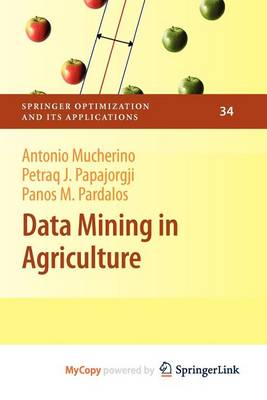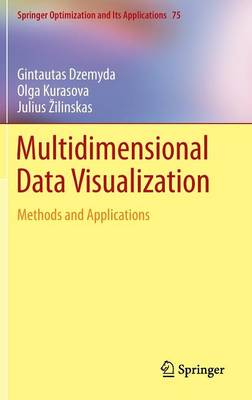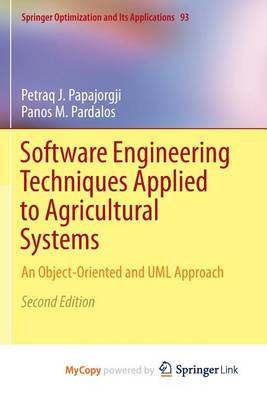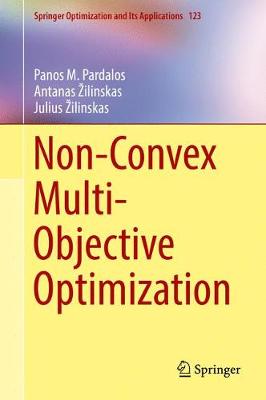Springer Optimization and Its Applications
9 primary works • 10 total works
Book 34
Data Mining in Agriculture
by Antonio Mucherino, Petraq J Papajorgji, and Panos M. Pardalos
Data Mining in Agriculture represents a comprehensive effort to provide graduate students and researchers with an analytical text on data mining techniques applied to agriculture and environmental related fields. This book presents both theoretical and practical insights with a focus on presenting the context of each data mining technique rather intuitively with ample concrete examples represented graphically and with algorithms written in MATLAB (R).
Book 53
Mathematical Aspects of Network Routing Optimization
by Carlos A S Oliveira and Panos M. Pardalos
Before the appearance of broadband links and wireless systems, networks have been used to connect people in new ways. Now, the modern world is connected through large-scale, computational networked systems such as the Internet. Because of the ever-advancing technology of networking, efficient algorithms have become increasingly necessary to solve some of the problems developing in this area.
"Mathematical Aspects of Network Routing Optimization" focuses on computational issues arising from the process of optimizing network routes, such as quality of the resulting links and their reliability. Algorithms are a cornerstone for the understanding of the protocols underlying multicast routing. The main objective in the text is to derive efficient algorithms, with or without guarantee of approximation. Notes have been provided for basic topics such as graph theory and linear programming to assist those who are not fully acquainted with the mathematical topics presented throughout the book.
"Mathematical Aspects of Network Routing Optimization" provides a thorough introduction to the subject of algorithms for network routing, and focuses especially on multicast and wireless ad hoc systems. This book is designed for graduate students, researchers, and professionals interested in understanding the algorithmic and mathematical ideas behind routing in computer networks. It is suitable for advanced undergraduate students, graduate students, and researchers in the area of network algorithms.
Book 75
Multidimensional Data Visualization
by Gintautas Dzemyda, Olga Kurasova, and Julius Zilinskas
This book highlights recent developments in multidimensional data visualization, presenting both new methods and modifications on classic techniques. Throughout the book, various applications of multidimensional data visualization are presented including its uses in social sciences (economy, education, politics, psychology), environmetrics, and medicine (ophthalmology, sport medicine, pharmacology, sleep medicine).
The book provides recent research results in optimization-based visualization. Evolutionary algorithms and a two-level optimization method, based on combinatorial optimization and quadratic programming, are analyzed in detail. The performance of these algorithms and the development of parallel versions are discussed.
The utilization of new visualization techniques to improve the capabilies of artificial neural networks (self-organizing maps, feed-forward networks) is also discussed.
The book includes over 100 detailed images presenting examples of the many different visualization techniques that the book presents.
This book is intended for scientists and researchers in any field of study where complex and multidimensional data must be represented visually.
Book 79
Cell Formation in Industrial Engineering
by Boris Goldengorin, Dmitry Krushinsky, and Panos M. Pardalos
This book focuses on a development of optimal, flexible, and efficient models and algorithms for cell formation in group technology. Its main aim is to provide a reliable tool that can be used by managers and engineers to design manufacturing cells based on their own preferences and constraints imposed by a particular manufacturing system. This tool could potentially lower production costs by minimizing other costs in a number of areas, thereby increasing profit in a manufacturing system.
In the volume, the cell formation problem is considered in a systematic and formalized way, and several models are proposed, both heuristic and exact. The models are based on general clustering problems, and are flexible enough to allow for various objectives and constraints. The authors also provide results of numerical experiments involving both artificial data from academic papers in the field and real manufacturing data to certify the appropriateness of the models proposed.
The book was intended to suit the broadest possible audience, and thus all algorithmic details are given in a detailed description with multiple numerical examples and informal explanations are provided for the theoretical results. In addition to managers and industrial engineers, this book is intended for academic researchers and students. It will also be attractive to many theoreticians, since it addresses many open problems in computer science and bioinformatics.
Book 93
Software Engineering Techniques Applied to Agricultural Systems
by Petraq J Papajorgji and Panos M. Pardalos
Book 113
Calculus of Tolerances in Combinatorial Optimization
by Boris Goldengorin, Gerold Jager, Panos M. Pardalos, and Marcel Turkensteen
Book 123
Non-Convex Multi-Objective Optimization
by Panos M. Pardalos, Antanas Zilinskas, and Julius Zilinskas
Book 126
Optimization and Management in Manufacturing Engineering
by Xinbao Liu, Jun Pei, Liu Liu, Hao Cheng, Mi Zhou, and Panos M. Pardalos
Problems facing manufacturing clusters that intersect information technology, process management, and optimization within the Internet of Things (IoT) are examined in this book. Recent advances in information technology have transformed the use of resources and data exchange, often leading to management and optimization problems attributatble to technology limitations and strong market competition. This book discusses several problems and concepts which makes significant connections in the areas of information sharing, organization management, resource operations, and performance assessment.
Geared toward practitioners and researchers, this treatment deepens the understanding between resource collaborative management and advanced information technology. Those in manufacturing will utilize the numerous mathematical models and methods offered to solve practical problems related to cutting stock, supply chain scheduling, and inventory management. Academics and students with a basic knowledge of manufacturing, combinatorics, and linear programming will find that this discussion widens the research area of resource collaborative management and unites the fields of information technology, manufacturing management, and optimization.Book 808
Mathematical Programming in Machine Learning
by O. Erhun Kundakcioglu and Panos M. Pardalos






